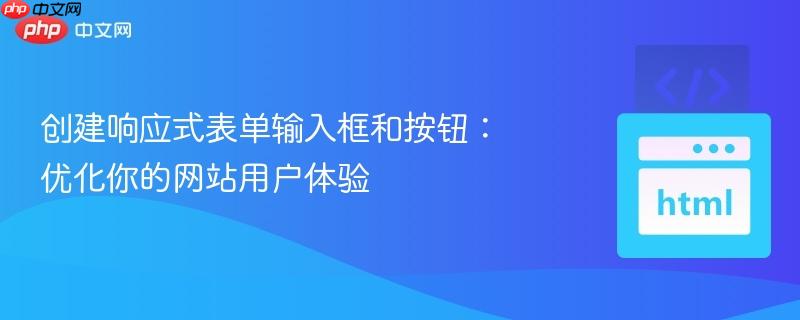
本文将帮助开发者解决在网页设计中遇到的响应式布局问题,特别是针对表单中的输入框和按钮在不同屏幕尺寸下的适配问题。我们将通过分析HTML结构和CSS样式,提供一种简单有效的解决方案,确保你的网站在各种设备上都能提供良好的用户体验。重点在于使用媒体查询来调整元素在不同屏幕尺寸下的显示方式,从而实现真正的响应式设计。
响应式设计是一种网页设计方法,旨在使网站能够自动适应不同设备(如桌面电脑、平板电脑、手机等)的屏幕尺寸和分辨率。其核心在于使用灵活的布局和媒体查询,根据设备的特性来调整网页的呈现方式。
在提供的代码中,按钮的错位问题主要源于以下几个因素:
解决这个问题的关键在于使用媒体查询,针对不同的屏幕尺寸调整按钮的浮动属性。当屏幕尺寸小于某个特定值(例如 1000px)时,将按钮的浮动属性设置为 float: left;,从而使其不再浮动到右侧,而是靠左对齐。
以下是修改后的 CSS 代码:
body {
margin: 0;
padding: 0;
background-color: #f1f1f1;
}
.topper-header {
padding-top: 50px;
text-align: center;
font-size: 250%;
font-weight: 25;
text-decoration: underline cyan;
}
.container {
overflow: hidden;
margin: auto;
}
#part4 {
display: flex;
justify-content: center;
align-items: center;
background-color: #f1f1f1;
padding-bottom: 100px;
}
.place-name {
text-align: center;
padding-right: 200px;
}
.row1 {
font-size: 15px;
margin-left: 20px;
width: 230px;
height: 30px;
border-style: groove;
border-radius: 3px;
}
.row2 {
margin-top: 15px;
border-radius: 3px;
font-size: 15px;
height: 30px;
width: 490px;
float: right;
border-style: groove;
}
.row3 {
margin-top: 15px;
border-radius: 3px;
border-style: groove;
font-size: 15px;
height: 100px;
width: 490px;
float: right;
}
#contact-input {
margin-left: 50px;
border-radius: 3px;
}
.row4 {
font-weight: 10;
border-radius: 3px;
background-color: #00ced1;
font-size: 20px;
float: right;
padding-right: 192px;
border-radius: 3px;
padding-left: 192px;
padding-top: 10px;
padding-bottom: 10px;
margin-top: 140px;
margin-right: -500px;
}
/* Added */
@media (max-width: 1000px) {
.row4 {
float: left;
margin-right: 0; /* 移除负边距 */
}
}这段代码的关键在于 @media (max-width: 1000px) 部分。它表示当屏幕宽度小于或等于 1000px 时,应用其中的 CSS 样式。 在媒体查询中,我们将 .row4 的 float 属性设置为 left,并移除了 margin-right,从而使按钮在小屏幕上靠左对齐,不再超出容器范围。
HTML 结构保持不变,因为问题主要出在 CSS 样式上。
<section id="part4">
<div class="container">
<h1 class="topper-header">CONTACT</h1>
<div id="contact-input">
<div class="first-row">
<span class="place-name">Zagatala,Zagatala City,Azerbaijan</span>
<input class="row1" type="text" placeholder="Name" required>
<input class="row1" type="text" placeholder="Phone">
</div>
<div class="second-row">
<input class="row2" type="email" placeholder="Email address">
</div>
<div class="third-row">
<textarea class="row3" placeholder="Message"></textarea>
<button class="row4">CONTACT US</button>
</div>
</div>
</div>
</section>使用相对单位: 尽量使用相对单位(如百分比、em、rem)来设置元素的宽度和高度,而不是固定像素值,以便更好地适应不同的屏幕尺寸。
弹性布局 (Flexbox) 或网格布局 (Grid): 使用 Flexbox 或 Grid 布局可以更方便地创建响应式布局,避免使用过多的浮动和定位。
视口 (Viewport) 设置: 确保在 HTML 文档的 <head> 部分设置了视口元数据,以便浏览器能够正确地缩放网页。
<meta name="viewport" content="width=device-width, initial-scale=1.0">
图片响应式: 使用 srcset 属性或 <picture> 元素来提供不同尺寸的图片,以便在不同的设备上加载最合适的图片。
测试: 在不同的设备和浏览器上测试你的网站,以确保其在各种环境下都能正常工作。
通过使用媒体查询调整按钮的浮动属性,我们可以有效地解决按钮在小屏幕上的错位问题,从而提高网站的响应式性能。 此外, 采用相对单位、使用 Flexbox 或 Grid 布局、设置视口元数据以及优化图片资源,能够进一步提升网站在各种设备上的用户体验。 响应式设计是一个持续学习和实践的过程,希望本文能够帮助你更好地理解和应用响应式设计原则。
以上就是创建响应式表单输入框和按钮:优化你的网站用户体验的详细内容,更多请关注php中文网其它相关文章!

每个人都需要一台速度更快、更稳定的 PC。随着时间的推移,垃圾文件、旧注册表数据和不必要的后台进程会占用资源并降低性能。幸运的是,许多工具可以让 Windows 保持平稳运行。

Copyright 2014-2025 https://www.php.cn/ All Rights Reserved | php.cn | 湘ICP备2023035733号